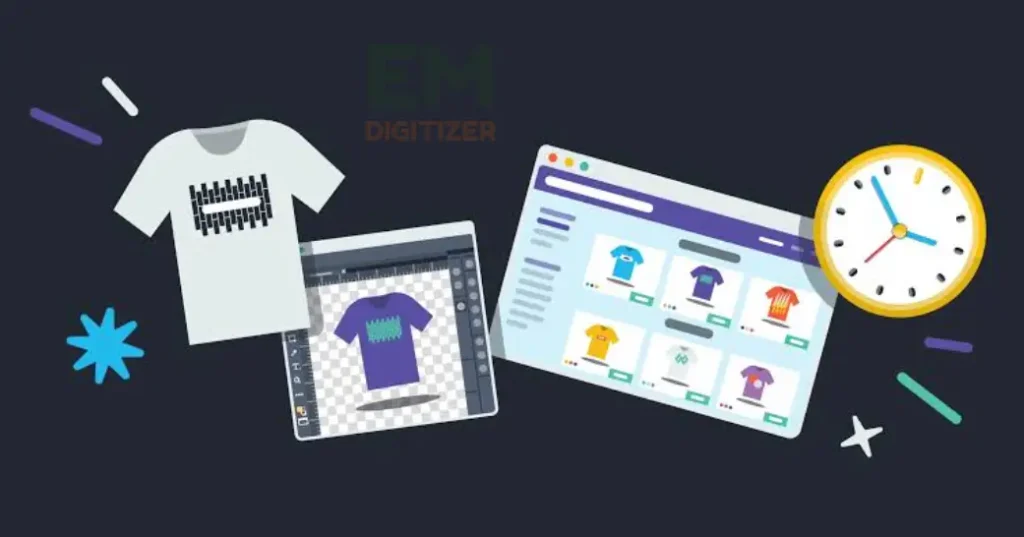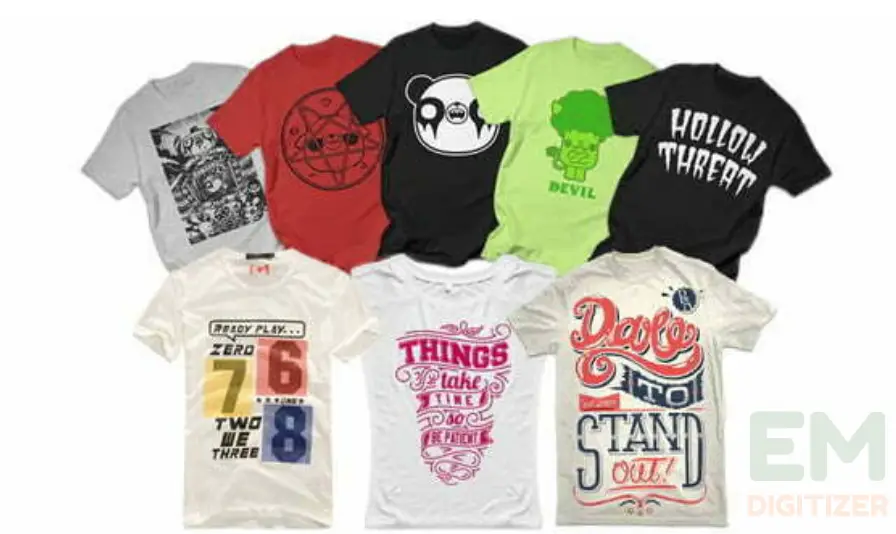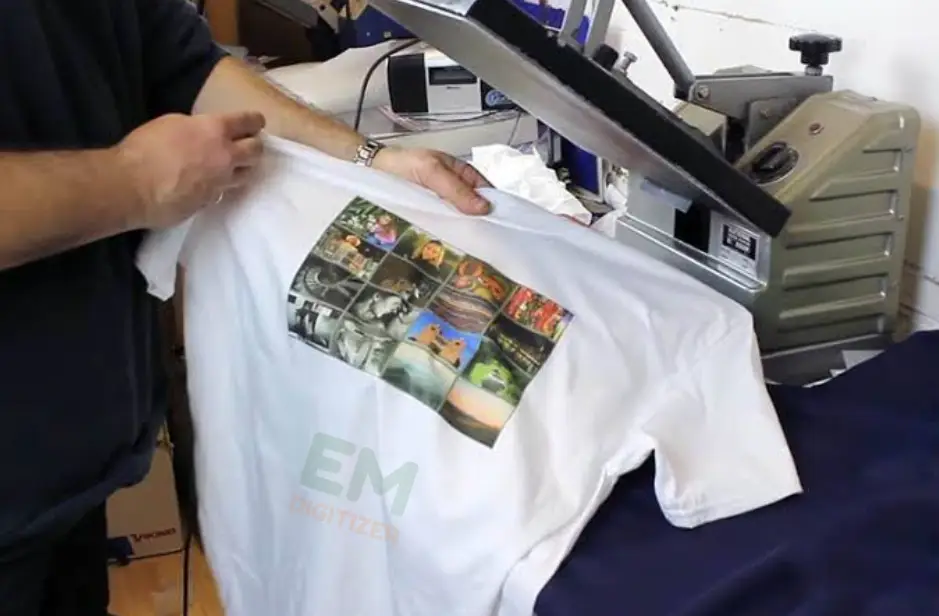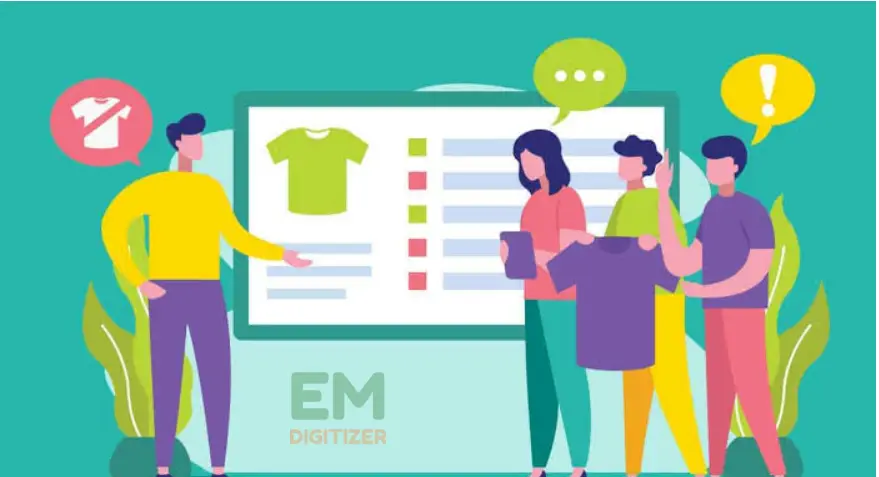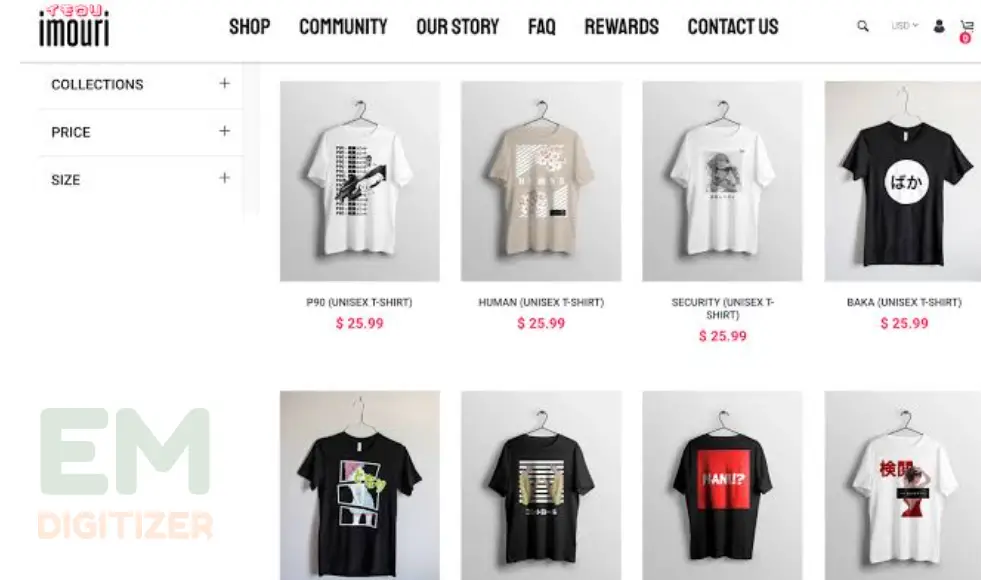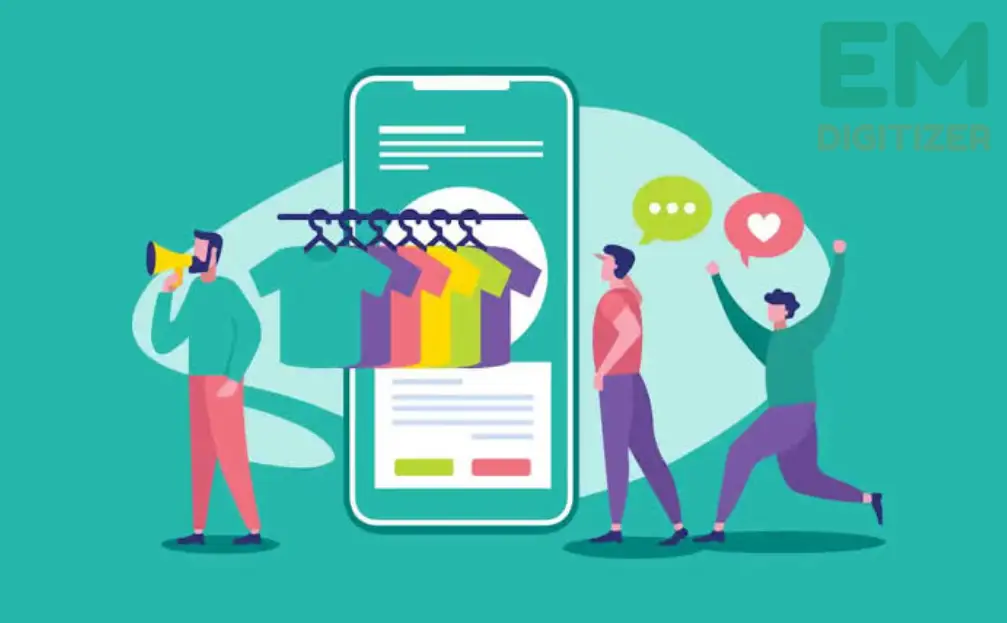How To Start A Successful T-Shirt Printing Business – Complete Guidance
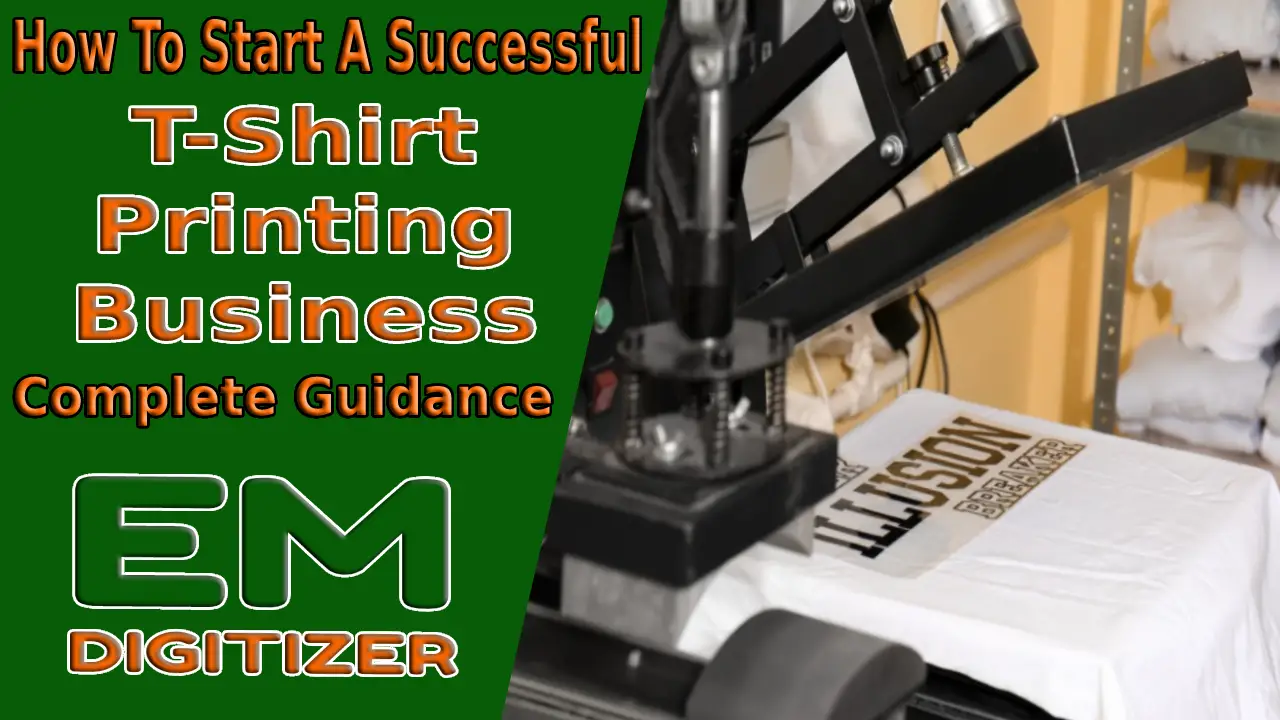
In today’s fashion-conscious world, personalized t-shirts have become a popular choice for individuals and businesses alike.
Starting a t-shirt printing business can be an exciting and profitable venture for creative entrepreneurs.
Whether you’re looking to sell custom t-shirts online or cater to local customers, this comprehensive guide will provide you with the necessary steps to launch a successful t-shirt printing business.
If you are looking for embroidery digitizing services, EMDigitizer is one of the best embroidery digitizing companies. Providing all types of embroidery digitizing Services. I recommend you try digitizing services.
Order NowGet Free QuoteTable of Contents
Overview
Entrepreneurs and aspiring designers who enter the t-shirt printing business often believe they can handle everything smoothly, but they encounter obstacles and become stuck once they begin their new venture.

This is primarily due to a lack of understanding of the market or target audience and a failure to stay updated on the latest trends.
Although these challenges may seem minor, they can arise at any point in the process, from designing to printing. We understand that each designer has their working style and every print shop operates by its own set of rules.
Here is a complete guide on 3 incredible ways to start a business with a heat press
Step By Step Guide
In this comprehensive guide, we will walk you through the essential steps to start a successful t-shirt printing business.
If you want to get knowledge about DTG Vs Screen Printing, then you can visit: DTG Vs Screen Printing
Step 01: Develop A Comprehensive Business Plan
To achieve success in any business endeavor, it is crucial to establish a strong and well-defined T-shirt business plan.
This principle holds, particularly in the t-shirt printing industry, where the target audience varies based on their preferences for quality, design, and style.
Next, it is essential to proceed with the following guidelines for the t-shirt printing business:
A. Determine The Market Niche
Market segmentation can be approached in two primary ways:
- Based on customer needs
- Based on customer age groups
To identify the appropriate market niche, consider the following questions:
- Will your t-shirt printing business cater to infants, toddlers, youth, teens, or adults?
- Will you provide customers with the option to customize their t-shirts, or will you offer a fixed range of designs to choose from?
- Will you focus on a specific niche within different age groups? For example, targeting teens with printed rock band t-shirts or adults with printed sports t-shirts.
- Will the fashion and quality of your printed t-shirts align with current market trends?
B. Choosing The Ideal Niche: Tips And Tricks
Here are some additional pointers for determining the perfect niche for your t-shirt printing business:
- Input relevant keywords associated with your niche, specify the targeted countries, and observe the suggested words and phrases.
- To refine the suggestions, consider factors like monthly search volume, competition level, and suggested bids.
- Assess the competition to gain insights about your rivals, and evaluate the suggested bid to gauge the level of commercial intent.
- Establish your t-shirt store with a unique selling proposition (USP) that focuses on customization.
- For further information, reach out to our industry experts.
Once you have completed the industry and market research, it is necessary to formulate a t-shirt business plan. When developing a plan for a printed t-shirt business, you should consider the following aspects:
- Define the mission of your company, which may involve offering high-quality printed t-shirts at affordable prices.
- Determine whether you will create your basic templates and designs or purchase pre-made designs.
- Consider the expectations you have for yourself, the management team, and other staff members.
- Identify the source of your raw materials.
- Will you have a designated supplier or purchase plain t-shirts from a specific brand?
- Develop marketing strategies based on thorough analysis, utilizing various channels such as events, social media, fairs, and conventions.
- Employing a social media scheduler can enhance productivity by allowing you to schedule social content in advance, simplifying social media activities.
- Gather supporting documents such as design samples, vendor agreements, and statistical analysis related to the t-shirt printing business.
- Obtain the necessary licenses applicable to your location and business type.
C. Consider The Financial Implications
Before establishing a t-shirt printing business like this, it is crucial to have a clear understanding of the associated costs.
If you are an entrepreneur with a long-term perspective, your financial plan should encompass the following points for the t-shirt printing business:
- Projected expenses and assumptions regarding fixed and variable costs
- Investment costs
- Revenue goals and potential revenue sources
- Break-even analysis
- Business ratios such as inventory turnover, accounts payable, and debt ratio
- Monthly profit or loss figures
- Annual gross margin
Additionally, it is important to include the following key expenses while planning to establish a t-shirt business:
- Printing
- Bagging
- Tagging
- Labeling
- Packing
- Shipping
- Tax
Obtaining printing quotes from different t-shirt printing companies will allow you to compare prices and secure the best deal without compromising quality. By addressing these aspects, you will be able to determine appropriate pricing for your t-shirts.
Launching a business in the coming year may pose challenges due to the potential recession in the global economy.
Therefore, it is essential to pay close attention to every detail to successfully establish your venture.
Following is a list of financial mistakes you need to avoid if you wish to make your business grow and become profitable.
Step 02: Selecting The E-commerce Solution For Your Online T-Shirt Store
The next crucial step is to consider the e-commerce platforms that will be utilized for your t-shirt printing online store. In this regard, you have two options available:
Choosing A Hosted Platform
The most prominent examples of hosted platforms are Shopify and Bigcommerce. These platforms offer a significant advantage by having a very low initial cost.
With a hosted platform, you can easily purchase a store, upload your brand’s logo, select a theme that suits your preferences, and promptly start selling printed t-shirts.
Opting For A Self-hosted Platform
Alternatively, you can opt for a custom-developed e-commerce solution tailored specifically for your t-shirt printing business and this approach provides you with the freedom to have your unique design and:
Make custom modifications as desired, access unlimited SEO options, and have complete control over adding products and setting prices at your convenience.
Step 03: Acquire An Online Product Designer Tool
When running a business that involves selling customized t-shirts, investing in a state-of-the-art product designer tool is highly beneficial.
By offering your customers the ability to design their t-shirts, you can make your online store stand out and provide a personalized touch.
To start, consider purchasing a basic online t-shirt design tool that meets your customers’ initial requirements. As your business grows, you can then upgrade your web-to-print software and introduce additional features.
Integrating a web-to-print designer tool can further enhance the uniqueness of your offerings, enabling a personalized experience and delivering exceptional customer satisfaction.
Step 04: Enhance The Functionality Of Your Design Tool
When designing t-shirts, individuals enjoy exploring various colors, designs, and templates. So, it is essential to incorporate a wide range of features into your tool, ensuring its user-friendliness.
By doing so, you will increase your chances of succeeding in the online t-shirt printing business:
1- Consider including a diverse selection of pre-made quotes, clipart, texts, and fonts in different styles, as well as graphics.
2- Moreover, you can introduce features such as masking effects, shadows, and overlapping to add visual appeal to their designs.
3- To go beyond mere customization, you can also provide an immersive experience through a 3D Configurator.
4- This tool enables users to build a t-shirt from scratch, allowing them to choose the pattern, and fabric, and add unique designs to any part of the garment.
Step 05: Choose The T-shirt Printing Technique You Will Employ
Once you have finalized your designs, it is time to proceed with the t-shirt printing process. There are four widely practiced approaches for printing t-shirts such as:
If you wish to operate your own printing company, you can also read the reviews of the top 5 best printing methods with pros and cons.
1) Screen Printing
An extremely popular technique for printing on t-shirts is screen printing, which is renowned for its capacity to deliver enduring and long-lasting results.
For comprehensive guidance on how to screen print with vinyl in detailed procedures, visit the blog.
Additionally, it enables you to expand your product line if desired by allowing printing on a variety of objects such as canvas goods, mugs, hats, and other accessories.
Pros
- Economical for large quantities
- Volume discounts available
Cons
- Not cost-effective for designs with multiple colors
- Limited to simple images and designs
For your convenience, we’ve compiled a list of the top automatic screen printing machine features in our blog.
2) Heat Transfer
This technique makes it easier to print designs from your home computer and iron them on, but it is not appropriate for managing a small t-shirt printing business.
Following are a few reasons for starting a heat transfer business to promote your creations.
Professional printing uses “plastisol transfers,” a more sophisticated type of heat transfer. These transfers are produced using premium heat-transfer paper by specialized printers.
Pros
- Each shirt can be printed on demand.
- No limitations on the number of colors that can be used in a print.
Cons
- Lower quality and less durability compared to direct-to-garment and screen printing.
- Requires a significant upfront investment in a heat press machine, ranging from a few hundred dollars to a few thousand.
- The do-it-yourself approach requires additional time and effort.
3) Direct-to-garment Printing
Heat transfers and screen printing cannot match the superiority of direct-to-garment printing in terms of print quality.
It functions similarly to an ink-jet printer and requires no setup fees, making it practical and affordable for printing modest orders.
Pros
- several color options.
- Precise detail accuracy in the printed design.
- Ideal for small orders or one-off prints.
- No setup costs.
Cons
- Not cost-effective for large-scale production runs.
- Generally, no volume discounts are available.
4) Embroidered Printing
The origins of this printing technique can be traced back to the 5th century BC, making it an ancient method.
Embroidered printing stands out as one of the most unconventional ways to print, as it involves the use of a sewing machine to stitch the design onto the t-shirt.
Many polo t-shirts are produced using this method, and it is also commonly employed for creating corporate t-shirts.
This blog provides you with all the tips and tricks to embroider t-shirts with the design of your choice.
Pros
- Screen printing is known for its durability.
- It provides a professional and polished appearance.
Cons
- Learning the technique can be challenging, and handling large volumes requires additional labor.
- Implementing intricate and small designs in embroidery can be difficult.
Step 06: Choose The Appropriate Supplier Of T-shirts
After deciding to enter the T-shirt printing industry, it is essential to acquire blank T-shirts for the printing process.
Conduct some research to identify a manufacturer capable of supplying high-quality blank T-shirts suitable for printing. Keep the following points in mind:
Product Quality
- Ensure that the chosen T-shirts do not experience issues such as fading, cracking, shrinking, or ripping, as this may discourage repeat purchases from customers.
- Pay attention to the fabric of the blank T-shirts, and the printing techniques involved, and adequately prepare your design file.
Want to consider the best and free t-shirt design software, go and read out the best software’s reviews.
Step 07: Establishing The Printing Infrastructure
Here are the recommended steps for carrying out the t-shirt business:
Determine The Color Schemes: It is advisable to decide on your color palette beforehand to avoid overlooking important details later on.
Whether you choose the garment or the ink first, this decision is crucial when starting an apparel order from scratch.
Create Backups: After receiving the final design from your customers, saving an editable file for yourself is essential. This allows you to make any necessary changes in the future if required.
Proceed With Printing The T-shirt: The next step involves printing the design onto the T-shirt. You can choose the printing method that you are most comfortable with, utilizing the printer of your preference.
If you lack expertise in the t-shirt printing business, it is recommended to hire professionals for the job.
Additionally, after printing the t-shirt, you must cure the garment and set the ink to ensure optimal washability.
Step 08: Establishing Logistics Infrastructure
After your customers place their t-shirt orders, it is essential to ensure timely delivery. You can achieve a smooth delivery process through the following three methods:
Independent Order Management
Your team and the labor force can help you manage the orders efficiently.
Drop-shipping
Another choice is to use a drop-shipper who can take care of order fulfillment to sell your goods.
Collaboration In Logistics
Alternatively, you might work with a logistics business to handle your order fulfillment and warehousing needs.
You might think about contracting out third-party warehousing as your t-shirt business expands and if you have the means.
Note: The preservation, packaging, and shipment of your orders is a specialty for many businesses.
Step 09: Launching Your Store
Finally, it’s time to start selling t-shirts! By letting your consumers create the most original t-shirt prints possible, you may inspire them to express their creativity.
You don’t need programming or coding knowledge to set up an online t-shirt printing store. A creative streak and a keen sense of style are all you need.
Starting with limited supplies, funding, and equipment is feasible for this type of business. Many businesses provide pre-built settings for your web-based t-shirt printing business.
Step 10: Promotion Of Your Store
To promote your t-shirt business effectively, consider the following strategies:
Printed Materials: Create and distribute flyers, pamphlets, and business cards with QR codes to nearby organizations, businesses, and schools.
Branding: Develop a memorable logo and a well-thought-out website to position your company as an industry authority. These components will give prospective consumers looking for t-shirts their initial impression.
Social Media Presence: Wear your merchandise and showcase it on platforms like Instagram. Interact with people, take pictures, and post them to make an impact.
Advertising Items: Distribute t-shirts with your business’s logo imprinted on them. Take into account event sponsorship, web advertising, and other sponsored marketing strategies.
Learn why companies require custom-embroidered t-shirts as part of their branding and marketing.
Online Activity: Create inquiries and polls using social media platforms, and regularly publish new content to draw followers.
personalization Options: Offer t-shirt personalization options in your shop to draw in consumers and keep them coming back, doubling your revenue!
Conclusion
Starting a successful t-shirt printing business requires careful planning, a strong understanding of your target market, quality products, and effective marketing strategies.
You may build a successful t-shirt printing business that satisfies both client needs and your love for originality by following the instructions provided in this tutorial.
Remember to adapt and evolve with the ever-changing market landscape, always delivering exceptional products and services that set you apart from the competition. Good luck as you pursue your business dreams!
To launch a T-shirt printing business, here are some initial steps you should consider:
Business Plan: Develop a comprehensive business plan that outlines your goals, target market, pricing strategy, marketing plan, and financial projections. This will serve as a roadmap for your business and help you make informed decisions.
Research and Target Market: Conduct market research to identify your target market, understand their preferences, and determine the demand for custom T-shirt printing in your area. This will help you tailor your products and marketing efforts accordingly.
Legal Considerations: Register your business with the appropriate local, state, or national authorities. Consult with a lawyer or business advisor to determine the legal structure of your business (sole proprietorship, partnership, LLC, etc.) and ensure compliance with any licensing requirements or regulations specific to your location.
Branding and Design: Create a compelling brand identity, including a memorable name, logo, and overall design aesthetic that resonates with your target market. Consider hiring a professional graphic designer to help you with this aspect.
Equipment and Supplies: Research and invest in the necessary equipment and supplies for T-shirt printing. This typically includes a heat press machine, screen printing equipment, or direct-to-garment (DTG) printer, as well as blank T-shirts, inks, and other printing materials. Determine the quantity and quality of equipment based on your expected production volume and budget.
Supplier Relationships: Establish relationships with reliable suppliers of blank T-shirts and printing materials. Ensure they offer good quality products and competitive pricing. Consider attending trade shows or reaching out to wholesalers and manufacturers to explore potential partnerships.
Production Space: Set up a production space that accommodates your printing equipment and provides sufficient storage for supplies. You may choose to operate from a dedicated storefront, a home-based workshop, or lease a commercial space depending on your budget and business scale.
Online Presence: Create a professional website or an online store to showcase your products, provide information about your services, and enable online ordering. Consider integrating e-commerce functionality and optimizing your website for search engines to increase visibility.
Marketing and Promotion: Develop a marketing strategy to generate awareness and attract customers. This may include online advertising, social media marketing, collaborations with influencers, participating in local events or fairs, and offering special promotions or discounts.
Customer Service and Fulfillment: Establish efficient order processing, production, and fulfillment procedures to ensure timely delivery of high-quality products. Provide excellent customer service to build a loyal customer base and encourage repeat business.
Remember, launching a successful business requires ongoing effort and adaptability. Continuously monitor market trends, customer feedback, and competition to refine your offerings and stay ahead in the industry.
You will need a heat press machine, screen printing equipment, or a direct-to-garment printer, depending on the printing method you choose.
Utilize social media, create a website, attend local events, collaborate with influencers, and offer special promotions to reach your target audience.
Consider factors like production costs, overhead expenses, and desired profit margin when setting your prices.
Check local regulations regarding business licenses, permits, and trademark/copyright issues.
Intense competition, managing inventory, maintaining consistent print quality, and keeping up with evolving fashion trends.
If you have any questions leave the comments or you can visit our social channels for more updates regularly. We provide embroidery digitizing services if you need digitizing services feel free to contact us or email us.


